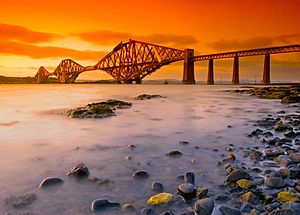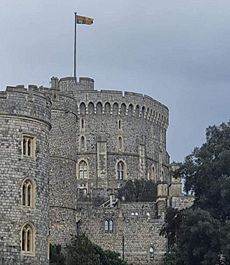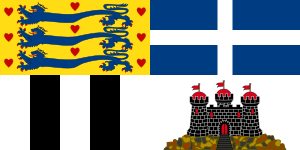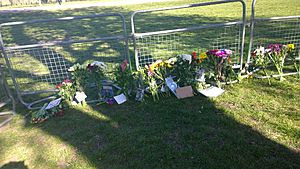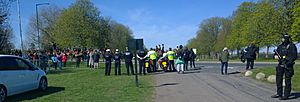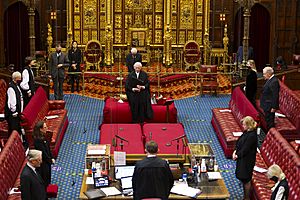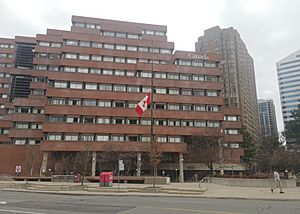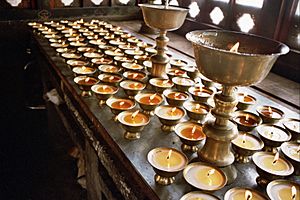Death and funeral of Prince Philip, Duke of Edinburgh facts for kids
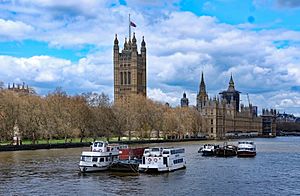
The Union Flag flying at half-mast at the Palace of Westminster on 9 April 2021
|
|
| Date | 9 April 2021 (date of death) 17 April 2021, 2:40–3:50 pm (BST) (date of ceremonial funeral) |
|---|---|
| Location | Windsor Castle, Berkshire, United Kingdom |
| Participants | See list |
Prince Philip, Duke of Edinburgh, who was the husband of Queen Elizabeth II and the longest-serving royal consort in British history, passed away at Windsor Castle. He was 99 years old and died on the morning of 9 April 2021, just two months before his 100th birthday. The royal family announced that he "died peacefully." His funeral took place on 17 April.
After the Duke's death, a special plan called Operation Forth Bridge was put into action. This plan included how to share the news, how the country would mourn, and details for his funeral. The Duke had wanted a smaller funeral. However, changes were also made to follow rules for the COVID-19 pandemic, like family members traveling from other countries needing to quarantine.
Leaders and groups from all over the world sent their deepest sympathies to the Queen, the British people, and citizens of the Commonwealth. People left flowers and messages at Buckingham Palace and Windsor Castle. Members of the royal family also shared their tributes to the Duke in the days after he passed away.
Contents
Prince Philip's Passing
His Health and Final Days
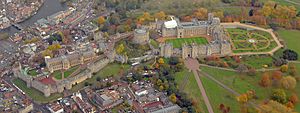
In the years before his death, Prince Philip, Duke of Edinburgh had to go to the hospital several times. In 2012, he was treated for a bladder infection. He had surgery on his stomach in 2013 and hip replacement surgery in 2018.
On 16 February 2021, the Duke went to King Edward VII's Hospital because he was feeling unwell. On 1 March, he was moved to St Bartholomew's Hospital for a heart procedure, which was successful. He returned to King Edward's on 5 March and was discharged to Windsor Castle on 16 March.
Three weeks after returning home, the royal family announced his death at noon on 9 April 2021. They stated he had "died peacefully" that morning at Windsor Castle. His daughter-in-law, Sophie, Countess of Wessex, said his death was "so gentle." The Queen was reportedly with him when he died.
Operation Forth Bridge: The Plan
The national plan for handling the Duke's death was named Operation Forth Bridge. It was named after the Forth Bridge near Edinburgh, the city of his dukedom. The plan was changed to fit the rules of the COVID-19 pandemic.
When he died, the plan began. Buckingham Palace sent a news release to the BBC and Press Association. Flags were lowered to half-mast and stayed that way during a period of national mourning. This mourning period lasted until the morning after his funeral.
All Union Flags and national flags were lowered. Government buildings were asked to fly the Union Flag at half-mast. However, the Royal Standard (the flag flying over Windsor Castle) stayed at full-mast. This is because it shows the living monarch is present. Members of Parliament wore black ties and armbands. No new laws were passed during the eight-day mourning period.
The BBC stopped most of its regular shows on 9 April. They played the national anthem and solemn music. Their TV channels showed special reports about the Duke's life. Other major British TV channels also changed their schedules. Many channels stopped their usual programs until later that day. BBC presenters wore black clothes during this time.
At 6 pm on 9 April, the tenor bell of Westminster Abbey rang once every minute for 99 minutes. This was to mark each year of the Duke's life.
The plan also included sharing the news across the Commonwealth of Nations. In Australia, the Governor-General David Hurley was in charge of informing the government and public. Military rehearsals for the funeral procession took place at Pirbright Camp and Windsor Castle.
The Funeral Service
The Duke's funeral happened on 17 April 2021 at St. George's Chapel in Windsor Castle.
Procession and Service Details
The Duke received a royal ceremonial funeral, not a state funeral. State funerals are usually for monarchs. He had asked for minimal "fuss." So, he did not lie in state for the public to view. His coffin rested in a private chapel at Windsor Castle before the service.
The funeral was televised. The BBC, ITV, Sky News, and major US networks broadcast the event. About 13.6 million people watched in the UK.
Before the service, military bands marched onto the Quadrangle of Windsor Castle. They played various songs, including "Jerusalem" and "Nimrod."
The Duke's coffin was carried on a special Land Rover Defender hearse. The Duke himself helped design this vehicle. The coffin was covered with his personal flag. His naval cap, sword, and a wreath of white roses and lilies with a note from the Queen were placed on it.
The Duke's four children, three of his grandchildren (Prince William, Prince Harry, Duke of Sussex, and Peter Phillips), his nephew, and his son-in-law walked behind the coffin. The Queen followed in the Bentley State Limousine. Members of the Royal Navy, Royal Marines, and Royal Air Force lined the route. The King's Troop, Royal Horse Artillery fired minute guns during the procession.
At the chapel steps, eight pallbearers from the Royal Marines carried the coffin. A guard of honour played the national anthem. A national minute's silence was held at 3 pm. About 730 members of the Armed Forces were at Windsor Castle.
David Conner, the Dean of Windsor, and Justin Welby, the Archbishop of Canterbury, led the service. The Duke's awards and decorations were displayed on the altar. A small choir of four singers performed.
There were no sermons or eulogies, as the Duke wished. The ceremony focused on his connections to the Royal Navy and the sea. The service began with the choir singing the Funeral Sentences.
The Dean of Windsor read from Ecclesiasticus, and the Archbishop of Canterbury read from the Gospel of John. The choir sang Psalm 104. Music included the hymn "Eternal Father, Strong to Save," which is linked to seafarers. The Dean praised the Duke's "unwavering loyalty" to the Queen and his service.
The coffin was lowered into the Royal Vault. The pipe major of the Royal Regiment of Scotland played a lament. The Duke's titles were announced. The bugle calls "Last Post" and "Reveille" were played. The service ended with "God Save the Queen."
The Duke was buried in the Royal Vault at St George's Chapel. When the Queen passes away, his remains will be moved to the King George VI Memorial Chapel to be buried next to her.
Attendees
| Attendee | Relation to Prince Philip |
|---|---|
| The Queen | Widow |
| The Prince of Wales and The Duchess of Cornwall | Son and daughter-in-law |
| The Duke and Duchess of Cambridge | Grandson and granddaughter-in-law |
| The Duke of Sussex | Grandson |
| The Princess Royal and Vice Admiral Sir Timothy Laurence | Daughter and son-in-law |
| Peter Phillips | Grandson |
| Zara and Michael Tindall | Granddaughter and grandson-in-law |
| The Duke of York | Son |
| Princess Beatrice and Edoardo Mapelli Mozzi | Granddaughter and grandson-in-law |
| Princess Eugenie and Jack Brooksbank | Granddaughter and grandson-in-law |
| The Earl and Countess of Wessex | Son and daughter-in-law |
| The Lady Louise Mountbatten-Windsor | Granddaughter |
| Viscount Severn | Grandson |
| The Duke of Gloucester | Cousin-in-law |
| The Duke of Kent | First cousin once removed |
| Princess Alexandra, The Hon. Lady Ogilvy | First cousin once removed |
| The Earl of Snowdon | Nephew |
| The Lady Sarah and Daniel Chatto | Niece and nephew-in-law |
| The Prince of Hohenlohe-Langenburg | Great-nephew |
| The Hereditary Prince of Baden | Great-nephew |
| The Landgrave of Hesse | Third cousin once removed |
| The Countess Mountbatten of Burma | First cousin once removed-in-law |
Due to COVID-19 rules, only 30 guests could attend the funeral. This meant only close family members were present inside the chapel. The Queen sat alone during the service. Everyone had to wear masks and could not sing.
The funeral broke royal tradition by having all family members wear formal day clothes instead of military uniforms. This also happened at the funerals of Diana, Princess of Wales, and Princess Margaret.
Prince Harry traveled from the United States to attend. His wife, Meghan, Duchess of Sussex, could not come because she was pregnant and did not get medical clearance. Prince Harry had to quarantine for five days upon arrival, but there was an exception for attending the funeral.
Other attendees included members of the Duke's German family. They had been unable to attend his wedding. They traveled to the UK and quarantined in Ascot, Berkshire. The prime minister, Boris Johnson, did not attend to allow more family members to be present.
Security Measures
Thames Valley Police increased security around Windsor before the funeral. Officers were deployed, and vehicle checks were done using special systems.
Reactions to His Death
From the Royal Family

Privately, the Queen said her husband's death left "a huge void in her life."
The Duke's children, Prince Charles, Anne, Princess Royal, Prince Andrew, Duke of York, and Prince Edward, Earl of Wessex, shared their tributes. Princess Anne said, "Without him, life will be completely different." Prince Charles called his father a "much loved and appreciated figure" who gave "remarkable, devoted service." Prince Harry and Meghan said he would be "greatly missed."
The Royal Family's website temporarily showed a black background with a statement. An online book of condolence was created for the public to share tributes. The royal family observed two weeks of mourning. Traditional gun salutes for the Queen's birthday were canceled.
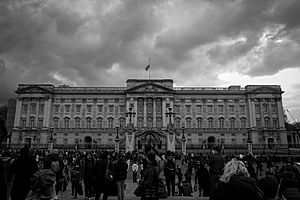
Many royal family members visited Windsor to support the Queen. Prince Andrew said the UK had lost the "grandfather of the nation." Princess Anne published a statement, calling her father her "teacher, supporter and critic."
The 74th British Academy Film Awards ceremonies paid tribute to the Duke. Prince William, the president of BAFTA, canceled his appearances. The Duke had been BAFTA's first president.
On 12 April, Prince William called the Duke an "extraordinary man." He felt "lucky to have not just had his example to guide me." A photo of the Duke with his great-grandson, Prince George, was released. Prince Harry said the Duke was "a man of service, honour and great humour." A photo of the Queen and the Duke with seven of their great-grandchildren was also shared.
Princess Eugenie thanked the Duke for his "dedication and love." Prince Edward said public messages were "uplifting." Mike Tindall, Princess Anne's son-in-law, shared a photo of his daughter with the Duke, calling him a "devoted family man." Meghan sent a personalized note and a wreath of flowers for the funeral. The wreath included flowers representing the Royal Marines, Greece, gratitude, remembrance, devotion, and his birth month.
Across the United Kingdom
Prime Minister Boris Johnson expressed his condolences. He said the Duke "helped to steer the Royal Family." Other political leaders and religious leaders also shared their sympathies. The House of Commons met early to allow MPs to pay tribute. Local election campaigns were paused.
At noon on 10 April, 41-gun salutes were fired across the UK, in Gibraltar, and on warships. Sporting events held a two-minute silence. A special service of remembrance was held at Canterbury Cathedral. Similar services took place across the UK.
On 17 April, events were held in Scotland and Northern Ireland. Gun salutes at Edinburgh Castle and Hillsborough Castle marked the minute's silence.
Public Tributes
The public was asked not to leave flowers due to COVID-19 rules. A notice about the Duke's death at Buckingham Palace was removed to prevent crowds. Despite this, many flowers and cards were left. An elegy (a sad poem) was published by Simon Armitage.
The Royal Family suggested supporting charities instead of leaving flowers. Flowers left at Windsor Castle were displayed privately. Some flowers from Buckingham Palace were taken to Marlborough House, where Prince Charles and Camilla, Duchess of Cornwall visited them. Crowds lined the streets near Windsor Castle on the funeral day.
The BBC's extensive coverage received many complaints. It became the most complained-about program in BBC history.
Crown Dependencies
The lieutenant governor of the Isle of Man sent condolences. Flags on public buildings were flown at half-mast. In Jersey and Guernsey, flags were also lowered, and tributes were paid. A 41-gun salute was sounded from Castle Cornet in Guernsey.
From Greece and Denmark
As the Duke was born in Greece, the Greek President, Katerina Sakellaropoulou, shared a photo of him as a boy. She acknowledged his service to the UK. Constantine II, the last King of the Hellenes, called the Duke "a remarkable man." A memorial prayer took place in Corfu, Greece, at the same time as the funeral.
In Denmark, where the Duke was also a prince by birth, Queen Margrethe II sent condolences. The Danish Royal House shared a portrait of the Duke wearing a Danish honour. Flags at the Queen's residence in Copenhagen were flown at half-mast.
From the Commonwealth
The Duke was an important figure in the Commonwealth of Nations. Leaders from many Commonwealth countries sent condolences. Many noted his support for organizations like the Duke of Edinburgh's Award. The Commonwealth Secretary-General also paid tribute.
Flags were flown at half-mast across the Commonwealth. In Australia, the flag was lowered on 10 April and 17 April. In Canada, flags were lowered on federal buildings until sunset on 17 April. New Zealand also lowered flags on government and naval buildings. In Malta, businesses put up posters and lowered flags. Forty-one gun salutes were fired in the Duke's honour across the Commonwealth.
Australia
Australia's government set up an online book of condolences. A 41-gun salute was held outside Parliament House on 10 April. A church service was held in Sydney, and a memorial service in Adelaide.
Canada
On 9 April, the bell at Peace Tower in Canada rang 99 times, one for each year of the Duke's life. A parliamentary motion expressed condolences. An online book of condolences was created due to the pandemic.
A national day of mourning was declared on 17 April. A televised national ceremony took place in Ottawa after the funeral in the UK. The Canadian government donated C$200,000 to The Duke of Edinburgh's International Award - Canada.
Cyprus
In Cyprus, where the Duke served in the Royal Navy, churches were encouraged to hold memorial services. A special service was held at St Paul's Anglican Cathedral in Nicosia.
Malta
On 17 April, a nine-gun salute was held in Valletta, one for each decade of his life. People also laid flowers at Villa Guardamangia in Pietà. This villa was where the Duke and Queen (then Princess Elizabeth) lived in the late 1940s.
New Zealand
A 41-gun salute was held in New Zealand on 11 April. MPs paid tribute and performed a traditional waiata. A memorial service was planned for 21 April.
Tanna, Vanuatu
The Kastom people on the island of Tanna in Vanuatu, who see Prince Philip as a god-like figure, also mourned his death. Village Chief Albi expressed sadness. Tribal leader Chief Yapa sent condolences. The Union Flag was flown at half-mast. A weeks-long mourning period was declared. Villagers held ceremonies to remember the Duke, with speeches and traditional drinks.
They believe the Duke's soul will return to Tanna. After mourning, they may transfer their respect to Prince Charles, who visited Vanuatu in 2018.
From Other Royal Families
Many heads of European royal families, most related to the Duke, shared their grief. These included the Kings and Queens of Belgium, Denmark, Netherlands, Norway, Spain, and Sweden. Other monarchs and royal heads from around the world also sent condolences.
Bhutan
King Jigme Khesar Namgyel Wangchuck and Queen Jetsun Pema of Bhutan ordered special prayers in monasteries. They lit 1000 butterlamps, which in Tibetan Buddhism symbolizes hope for the soul's enlightenment.
Luxembourg
Flags at the Grand Ducal Palace and Berg Castle were flown at half-mast on the funeral day.
Norway
The Norwegian Royal House announced that a flag would be flown at half-mast from the balcony of the Royal Palace, Oslo, on 9 April and on the funeral day.
Sweden
Sweden honored the Duke, who was a Knight of the Order of the Seraphim. The Royal Standard of Sweden was flown at half mast from Stockholm Palace. The Duke's coat of arms was taken to Riddarholmen Church, where a traditional bell tolling took place. The Swedish Royal Family sent wreaths.
International Reactions
Leaders from many nations, including the president of the European Commission, the Secretary-General of the United Nations, and Pope Francis, paid tribute. The 14th Dalai Lama also sent his sympathies.
Ireland
On the funeral day, the Irish National flag at all State buildings in Ireland was flown at half-mast. This was done as a "mark of respect." The flag was also lowered for Diana's funeral in 1997 and the Queen Mother's death in 2002.
Images for kids
-
Floral tributes to Prince Philip outside the gates of Sandringham House, Norfolk.
-
The High Commission of Cyprus in London flew the flags of Cyprus and the European Union at half-mast on the day of the funeral.
See also
 In Spanish: Muerte y funeral de Felipe de Edimburgo para niños
In Spanish: Muerte y funeral de Felipe de Edimburgo para niños


